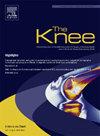MCP-1 in synovial fluid as a predictor of inferior clinical outcomes after meniscectomy
IF 1.6
4区 医学
Q3 ORTHOPEDICS
引用次数: 0
Abstract
Purpose
To evaluate knee intra-articular cytokine concentrations in patients undergoing isolated meniscectomy and determine if these concentrations are associated with clinical outcomes.
Methods
Concentrations of ten biomarkers were quantified in synovial fluid aspirated from the operative knees of patients who underwent isolated meniscectomy from 10/2011-12/2019. Patients completed a survey at final follow-up including VAS, Lysholm, Tegner, and KOOS Physical Function Short Form (KOOS-PS). Failure was defined as subsequent TKA or non-achievement of the Patient Acceptable Symptom State (PASS) for knee pain defined as VAS > 27/100. Regression analysis investigating the relationship between cytokine concentrations and failure was performed.
Results
The study consisted of 100 patients, including 50 males (50.0%) with a mean age of 51.1 ± 11.7 years, a median BMI of 28.9 kg/m2 [25.5, 32.4], and a mean follow-up of 8.0 ± 2.2 years. There were no demographic or clinical differences between failures (n = 41) and non-failures (n = 59) at baseline. Monocyte Chemotactic Protein 1 (MCP-1) concentration was significantly higher in failures than in non-failures (344.3 pg/ml vs. 268.6 pg/ml, p = 0.016). In a regression analysis controlling for age, sex, BMI, symptom duration, length of follow-up, and ICRS grade, increased MCP-1 was associated with increased odds of failure (p = 0.002).
Conclusions
The concentration of MCP-1 on the day of arthroscopic meniscectomy was predictive of failure as defined by an unacceptable pain level at intermediate- to long-term follow-up. This finding may help identify patients at high risk for poor postoperative outcomes following isolated meniscectomy and serve as a target for future postoperative immunomodulation research.
滑液中的 MCP-1 可预测半月板切除术后的不良临床结果
目的评估接受孤立性半月板切除术的患者膝关节内细胞因子的浓度,并确定这些浓度是否与临床结果相关。方法对 2011 年 10 月至 2019 年 12 月期间接受孤立性半月板切除术的患者从手术膝关节抽取的滑液中的十种生物标志物的浓度进行量化。患者在最终随访时完成了一项调查,包括 VAS、Lysholm、Tegner 和 KOOS Physical Function Short Form (KOOS-PS)。失败定义为后续TKA或膝关节疼痛未达到患者可接受症状状态(PASS),定义为VAS > 27/100。研究对细胞因子浓度与失败之间的关系进行了回归分析。 结果该研究共有 100 例患者,其中男性 50 例(50.0%),平均年龄(51.1 ± 11.7)岁,中位体重指数(BMI)为 28.9 kg/m2 [25.5, 32.4],平均随访时间(8.0 ± 2.2)年。失败者(41 人)和非失败者(59 人)在基线时没有人口统计学或临床差异。失败者的单核细胞趋化蛋白 1 (MCP-1) 浓度明显高于非失败者(344.3 pg/ml vs. 268.6 pg/ml,p = 0.016)。结论 关节镜下半月板切除术当天的 MCP-1 浓度可预测中长期随访时无法接受的疼痛程度所定义的手术失败。这一发现可能有助于识别孤立半月板切除术后术后效果不佳的高风险患者,并作为未来术后免疫调节研究的目标。
本文章由计算机程序翻译,如有差异,请以英文原文为准。
求助全文
约1分钟内获得全文
求助全文
来源期刊

Knee
医学-外科
CiteScore
3.80
自引率
5.30%
发文量
171
审稿时长
6 months
期刊介绍:
The Knee is an international journal publishing studies on the clinical treatment and fundamental biomechanical characteristics of this joint. The aim of the journal is to provide a vehicle relevant to surgeons, biomedical engineers, imaging specialists, materials scientists, rehabilitation personnel and all those with an interest in the knee.
The topics covered include, but are not limited to:
• Anatomy, physiology, morphology and biochemistry;
• Biomechanical studies;
• Advances in the development of prosthetic, orthotic and augmentation devices;
• Imaging and diagnostic techniques;
• Pathology;
• Trauma;
• Surgery;
• Rehabilitation.
 求助内容:
求助内容: 应助结果提醒方式:
应助结果提醒方式:


